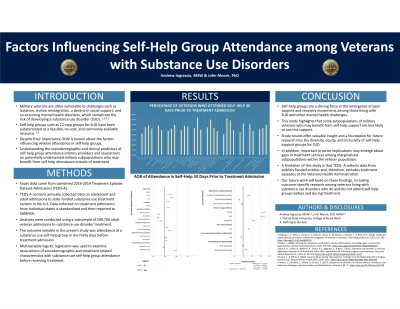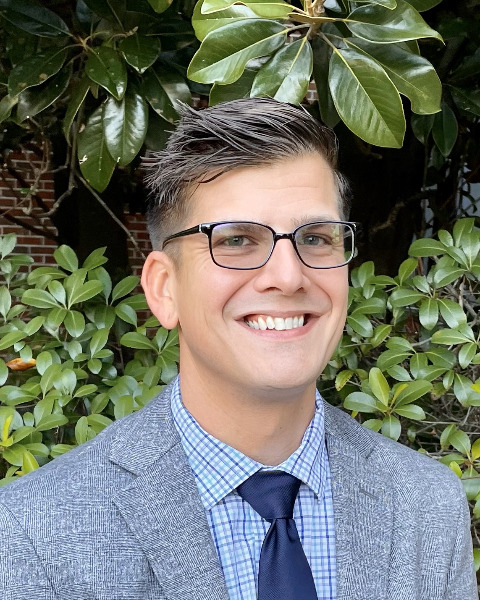Back


(93) Factors Influencing Self-Help Group Attendance in Veterans with Substance Use Disorders
Saturday, April 6, 2024
9:45 AM – 1:15 PM

Has Audio

Andrew Ingrassia, MSW
Doctoral Student
Florida State University, Florida- JM
John Moore, PhD
Assistant Professor
Florida State University, Florida
Presenter(s)
Non-presenting author(s)
Background & Introduction: Military veterans are often vulnerable to challenges such as isolation, civilian reintegration, a decline in social support, and co-occurring mental health disorders, which complicate the risk of developing a substance use disorder (SUD). Approximately 11% of military veterans entering the Veteran Administration healthcare system meet the diagnostic criteria of a SUD. Self-help groups such as 12-step groups for SUD have been substantiated as a feasible, no-cost, and commonly available enhancement to formal treatment. Attendance in self-help groups strengthens veteran social support and may be an essential factor in veteran civilian reintegration and reducing the risk of SUD. Despite their importance, little is known about the factors influencing veteran attendance in self-help groups. This study examines these factors in veterans with SUD. Such work informs substance use treatment professionals about potentially under-served individuals seeking treatment.
Methods: Data came from combined 2016 - 2019 Treatment Episode Dataset-Admissions (TEDS-A). TEDS-A collects annual data on adolescent and adult admissions from state-certified substance use treatment centers in the United States. Analyses were conducted using a subsample of 199,7096 veteran admissions to substance use disorder treatment. The outcome variable in the present study was attendance at a substance use self-help group in the thirty days prior to treatment admission. TEDS-A defines a substance use self-help group as attending Alcoholics Anonymous, Narcotics Anonymous, or any other support group that is focused on substance use recovery. Multivariable logistic regression was used to examine associations of sociodemographic and treatment related characteristics with substance use specific self-help group attendance prior to receiving treatment. Sociodemographic variables included in multivariable analyses were sex, age, race/ethnicity, educational attainment, employment status, and living situation. Treatment related characteristics included in analyses were treatment history, treatment referral source, and comorbid mental health condition(s). Results from the final multivariable logistic regression model are presented as adjusted odds ratios (AORs) with 95% confidence intervals (CI).
Results: In terms of sociodemographic characteristics, females had higher odds of self-help attendance (AOR = 1.15, 95% CI 1.11-1.20) relative to males. Compared to admissions aged 18 through 24, those aged 35 through 49 had the highest odds of reporting attendance in self-help (AOR = 1.32, 95% CI = 1.24-1.42), followed by those aged 25 through 34 (AOR = 1.21, 95% CI = 1.12-1.29). Compared to white admissions, Latinx admissions had the lowest odds of self-attendance (AOR = 0.70, 95% CI = 0.67-0.73), followed by African Americans (AOR = 0.74, 95% CI = 0.71-0.76). Additionally, living in a supervised setting, being out of the workforce, and having educational attainment > high school were each associated with higher odds of self-help group attendance respective to their reference categories.
Regarding treatment-relevant factors, admissions referred to treatment by the criminal justice system had the lowest odds of reporting attendance in self-help groups relative to the odds of admissions with an individual or self-referral (AOR = 0.79, 95% CI = 0.76-0.82). Compared to those with no prior history of substance use treatment, those with a prior history of treatment had higher odds of self-help attendance (AOR = 1.32, 95% CI = 1.28-1.36). Additionally, admissions with no co-occurring mental health conditions had lower odds of self-help attendance compared to those with a co-occurring mental health condition (AOR = 0.90, 95% CI = 0.87-0.92 ).
Conclusion & Discussion: Self-help groups such as 12-step sobriety groups are a driving force in the emergence of peer support and recovery movements among those living with substance use disorders and other mental health challenges. Self-help support is a readily available and substantiated enhancement to formal substance use treatment. This study highlights that some subpopulations of military veterans who may benefit from self-help support are less likely to use this support. Strategies to improve community engagement in substance use self-help support are recommended, especially for racial minorities, those involved in the criminal justice system, and younger individuals. A limitation of this study is that TEDS- A collects data from publicly funded entities and, therefore, excludes treatment episodes at the Veterans Health Administration. Our future work will build on these findings and may include outcome-specific research among veterans living with substance use disorders who do and do not attend self-help groups.
References: Drebing, C. E., Reilly, E., Henze, K. T., Kelly, M., Russo, A., Smolinsky, J., Gorman, J., & Penk, W. E. (2018). Using peer support groups to enhance community integration of veterans in transition. Psychological Services, 15(2), 135–145. https://doi.org/10.1037/ser0000178
Kelly, J. F. (2003). Self-help for substance-use disorders: History, effectiveness, knowledge gaps, and research opportunities. Clinical Psychology Review, 23(5), 639–663. https://doi.org/10.1016/s0272-7358(03)00053-9
Seal, K. H., Cohen, G., Waldrop, A., Cohen, B. E., Maguen, S., & Ren, L. (2011). Substance use disorders in Iraq and Afghanistan veterans in VA Healthcare, 2001–2010: Implications for screening, diagnosis and treatment. Drug and Alcohol Dependence, 116(1–3), 93–101. https://doi.org/10.1016/j.drugalcdep.2010.11.027
Suntai, Z., & White, B. (2022). Social isolation among older veterans: Findings from the National Health and Aging Trends Study. Aging & Mental Health, 26(7), 1345–1352. https://doi.org/10.1080/13607863.2021.1942434
Teeters, J., Lancaster, C., Brown, D., & Back, S. (2017). Substance use disorders in military veterans: Prevalence and treatment challenges. Substance Abuse and Rehabilitation, Volume 8, 69–77. https://doi.org/10.2147/sar.s116720
Methods: Data came from combined 2016 - 2019 Treatment Episode Dataset-Admissions (TEDS-A). TEDS-A collects annual data on adolescent and adult admissions from state-certified substance use treatment centers in the United States. Analyses were conducted using a subsample of 199,7096 veteran admissions to substance use disorder treatment. The outcome variable in the present study was attendance at a substance use self-help group in the thirty days prior to treatment admission. TEDS-A defines a substance use self-help group as attending Alcoholics Anonymous, Narcotics Anonymous, or any other support group that is focused on substance use recovery. Multivariable logistic regression was used to examine associations of sociodemographic and treatment related characteristics with substance use specific self-help group attendance prior to receiving treatment. Sociodemographic variables included in multivariable analyses were sex, age, race/ethnicity, educational attainment, employment status, and living situation. Treatment related characteristics included in analyses were treatment history, treatment referral source, and comorbid mental health condition(s). Results from the final multivariable logistic regression model are presented as adjusted odds ratios (AORs) with 95% confidence intervals (CI).
Results: In terms of sociodemographic characteristics, females had higher odds of self-help attendance (AOR = 1.15, 95% CI 1.11-1.20) relative to males. Compared to admissions aged 18 through 24, those aged 35 through 49 had the highest odds of reporting attendance in self-help (AOR = 1.32, 95% CI = 1.24-1.42), followed by those aged 25 through 34 (AOR = 1.21, 95% CI = 1.12-1.29). Compared to white admissions, Latinx admissions had the lowest odds of self-attendance (AOR = 0.70, 95% CI = 0.67-0.73), followed by African Americans (AOR = 0.74, 95% CI = 0.71-0.76). Additionally, living in a supervised setting, being out of the workforce, and having educational attainment > high school were each associated with higher odds of self-help group attendance respective to their reference categories.
Regarding treatment-relevant factors, admissions referred to treatment by the criminal justice system had the lowest odds of reporting attendance in self-help groups relative to the odds of admissions with an individual or self-referral (AOR = 0.79, 95% CI = 0.76-0.82). Compared to those with no prior history of substance use treatment, those with a prior history of treatment had higher odds of self-help attendance (AOR = 1.32, 95% CI = 1.28-1.36). Additionally, admissions with no co-occurring mental health conditions had lower odds of self-help attendance compared to those with a co-occurring mental health condition (AOR = 0.90, 95% CI = 0.87-0.92 ).
Conclusion & Discussion: Self-help groups such as 12-step sobriety groups are a driving force in the emergence of peer support and recovery movements among those living with substance use disorders and other mental health challenges. Self-help support is a readily available and substantiated enhancement to formal substance use treatment. This study highlights that some subpopulations of military veterans who may benefit from self-help support are less likely to use this support. Strategies to improve community engagement in substance use self-help support are recommended, especially for racial minorities, those involved in the criminal justice system, and younger individuals. A limitation of this study is that TEDS- A collects data from publicly funded entities and, therefore, excludes treatment episodes at the Veterans Health Administration. Our future work will build on these findings and may include outcome-specific research among veterans living with substance use disorders who do and do not attend self-help groups.
References: Drebing, C. E., Reilly, E., Henze, K. T., Kelly, M., Russo, A., Smolinsky, J., Gorman, J., & Penk, W. E. (2018). Using peer support groups to enhance community integration of veterans in transition. Psychological Services, 15(2), 135–145. https://doi.org/10.1037/ser0000178
Kelly, J. F. (2003). Self-help for substance-use disorders: History, effectiveness, knowledge gaps, and research opportunities. Clinical Psychology Review, 23(5), 639–663. https://doi.org/10.1016/s0272-7358(03)00053-9
Seal, K. H., Cohen, G., Waldrop, A., Cohen, B. E., Maguen, S., & Ren, L. (2011). Substance use disorders in Iraq and Afghanistan veterans in VA Healthcare, 2001–2010: Implications for screening, diagnosis and treatment. Drug and Alcohol Dependence, 116(1–3), 93–101. https://doi.org/10.1016/j.drugalcdep.2010.11.027
Suntai, Z., & White, B. (2022). Social isolation among older veterans: Findings from the National Health and Aging Trends Study. Aging & Mental Health, 26(7), 1345–1352. https://doi.org/10.1080/13607863.2021.1942434
Teeters, J., Lancaster, C., Brown, D., & Back, S. (2017). Substance use disorders in military veterans: Prevalence and treatment challenges. Substance Abuse and Rehabilitation, Volume 8, 69–77. https://doi.org/10.2147/sar.s116720
Learning Objectives:
- Describe the predictors of self-help support group attendance among military veterans with substance use disorders.
- Assess their practice to include sub-populations of military veterans who may not engage in community self-help for substance use.
- Discuss the impact of socioeconomic disparities on attendance in self-help support group attendance.
